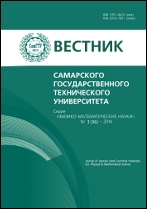|
This article is cited in 3 scientific papers (total in 3 papers)
Mathematical Modeling
A method for the fast MOID computation for two confocal heliocentric orbits
A. E. Derevyanka
Samara State Technical University, Samara, 443100, Russian Federation
(published under the terms of the Creative Commons Attribution 4.0 International License)
Abstract:
The paper is on the problem of classification an asteroid as potentially hazardous (PHA), namely the estimation of the MOID parameter. Minimum Orbital Intersection Distance describes the minimal distance between two confocal heliocentric orbits. Analytical, numerical and hybrid methods used for the MOID estimation are reviewed. A brief description of the K. V. Kholshevnikov and G. F. Gronchi analytical methods, which are considered to be classical, is given. The task of calculating the MOID parameter for a large number of asteroids (more than 10,000) with a maximum calculating speed and the ability to parallelize the process is set. A numerical method based on geometrical considerations concerning the location of the bodies on their orbits is proposed. Let us consider two bodies $A$ and $E$. Since only the minimum distance between two orbits is required, the information on the actual position of the bodies on their orbits is insignificant. The idea is to calculate one full revolution of the body $A$. For each position of body $A$ the corresponding position of the body $E$ is calculated under the following assumption. Consider a plane $P$, comprising the body $A$ and the Sun. Therefore, plane $P$ is perpendicular to the orbital plane of the body $E$. Of the two points at which the plane $P$ intersects the orbit of the body $E$, $E$ is considered to be at the point that is the nearest the body $A$. Thus, the position of the body $E$ will depend on the position of the body $A$. As a result, from the geometric assumptions on the triangle formed by the Sun and two bodies, the distance between $A$ and $E$ is calculated. When one complete revolution of the body $A$ with a certain step is calculated, we receive a set of the distances between two orbits, from which we can identify the areas of the local minima of the discrete representation of the distance function (the distance between the orbits of $A$ and $E$). Then, the procedure of tuning is carried out to verify and precise the values of local minima of discrete representation of the distance function. As a result, the smallest value of the local minima is considered to be the estimation of the Minimum Orbital Intersection Distance (MOID) takes. Pros of the suggested method are as follows: high speed and adjustable calculation accuracy, the suitability to the use of parallel computing. Comparative tests of the described method were carried out. The results received are consistent with the classical G. F. Gronchi method.
Keywords:
MOID, potentially hazardous asteroids, orbital elements, celestial mechanics.
Original article submitted 15/X/2014
revision submitted – 12/XI/2014
Citation:
A. E. Derevyanka, “A method for the fast MOID computation for two confocal heliocentric orbits”, Vestn. Samar. Gos. Tekhn. Univ., Ser. Fiz.-Mat. Nauki [J. Samara State Tech. Univ., Ser. Phys. Math. Sci.], 4(37) (2014), 144–156
Linking options:
https://www.mathnet.ru/eng/vsgtu1344 https://www.mathnet.ru/eng/vsgtu/v137/p144
|

| Statistics & downloads: |
| Abstract page: | 527 | | Full-text PDF : | 268 | | References: | 87 |
|




 Contact us:
Contact us: Terms of Use
Terms of Use
 Registration to the website
Registration to the website Logotypes
Logotypes









 Citation in format
Citation in format 
